-

Miami Dolphins QB Tua Tagovailoa Talks New Tatau
Samoan Quarterback Tua Tagovailoa of the Miami Dolphins fronted questions about his new right arm sleeve, after the Dolphins’ first practice of training camp. The tatau that was revealed by the Miami Dolphins Twitter/X account back in July {{34881}} “It’s a piece that represents my first child. There’s a lot of things that go on behind it, a lot of cultural significance, a lot of things that has to do with protection, guidance, sort of things like that that we believe in the Samoan culture, so that’s what it is." and here's what some pundits had to say about the new ink! {{34882}} The Miami Dolphins have had a barn burner of a start to their 2023-2024 season, currently on a three-game winning streak, which includes a record-breaking 70-20 win over the Denver Broncos. {{34884}} In that game, Tagovailoa threw 309 yards for four touchdowns, with the team finishing with 726 yards on offensive, being the second team to ever put up more than 700 offensive yards
-
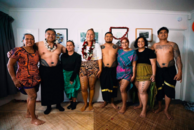
New Zealand Deputy Prime Minister wears Samoa on her skin
In an historic first, NZ's Deputy Prime Minister Carmel Sepuloni had the Samoan malu bestowed on her by renowned Tufuga Li'aifaiva Lavea Fesola'i Imo. Watch Carmel's beautiful day as she underwent the 6 hour tatau process, surrounded by friends and family in this emotional ceremony. The Deputy PM speaks of the honour of wearing these ancestral marks in her high profile position as a key leader of the nation, and breaks down her background, upbringing and reasons for finally getting the malu done. Like many Kiwi Pacificans, she speaks of the cultural challenges she worked through to feel ready to wear the malu, and the things that changed this for her in her later life. Carmel's malu journey is an inspirational story that will resonate well with so many others in our adopted Aotearoa homeland.
-
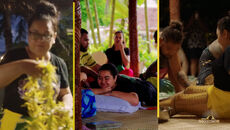
Malu Tips with Suluafi Brianna Fruean
"Being gifted the malu is like having Samoa tattooed into your body" As more and more women look forward to receiving their malu -particularly in the diaspora, we take you on a journey to know the basics about how to prepare, what to wear, what you need to take and what to expect. This important part of Samoan culture is a special time for families, and being prepared with knowledge and know-how is what may help to navigate this ceremony with confidence. Here are some basic tips on the who, how, what and why to prepare for a Malu and the Samaga ceremony that is part of this celebration.
-
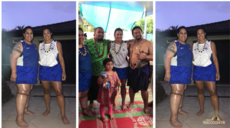
Inked - Liz Patu - Tales of Tatau
Liz Patu is a professional rugby player and has made history as Australia's most capped female rugby player. The 32 year old Samoan was born in Auckland and then raised in Samoa before moving to Australia to live when she was 14yrs old. She plays club rugby for the Queensland Reds and made her debut for the Wallaroos in 2014 for the Womens Rugby World Cup. Whenever she's on the field, you can see her beautiful malu on display! Here Liz shares with us about her malu journey, what the malu signifies to her, why she decided to get her malu and more.
-
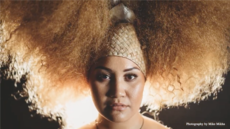
O LA’U MALAGA - MALUOAIGA: MY JOURNEY AS A SĀMOAN/MĀORI WOMAN
Pacific Wave is proud to present O LA’U MALAGA - MALUOAIGA: MY JOURNEY AS A SĀMOAN/MĀORI WOMAN’, a film that was produced by Pacific Wave Radio Hosts, Kimaea Kirifi-Ali’ifa’alogo & Pele Vaimoso. The film documents Kirifi-Ali’ifa’alogo as she embarks on her Malofie journey and the struggles she’s had with identity as a “half cast” Samoan - with her father being from Sāmoa and her mother being of Māori descent.
-
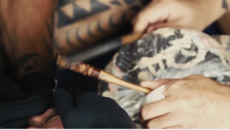
Keone Nunes, Master Hawaiian Tattooist
Well-known Hawaiian traditional tattooist Keone Nunes helped Oakland Museum of California to conceptualize the tattoo section in the Pacific Worlds exhibition. Nunes visited California in September and October in part because he was asked to tattoo Native Californians in the Arcata area with their own ancestral designs. His visit was a follow up to a first trip a dozen years ago, and Nunes said he sees these invitations as an enormous honor and responsibility. At OMCA, Nunes toured Pacific Worlds and sat down with us to speak about his tattoo practice, what it means to carry traditional knowledge forward to the future, and how tattooing is an expression of sovereignty.
-
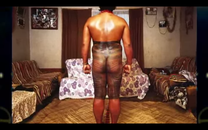
Traditional Samoan Tattooing tools
It's often a painful experience getting a tattoo; whether it's done traditionally or non-traditionally. Te Papa curator Sean Mallon explains why it is so important in the Samoan culture to get a tattoo the traditional way using bone chisels.
-
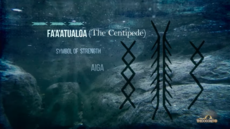
Tatau Patterns Explained By Tyla Vaeau | Cultural Refresh
Samoan tattooist Tyla Vaeau goes through different symbols of the Malu and explains each of their significant meanings. She explores some different interpretations of the meanings of these age old symbols and the importance that they hold in Samoan culture. The work of many different tufuga are seen in this video, including the beautiful Malu created by: Le Aiga Sa Su’a dynasty of tatau artists, Li’aifaiva Malofie and Su’a Faumuina Tupou Su’a from Gagaifo, Lefaga who created the beautiful measina of Tupe Lualua as seen in this piece. - ‘Cultural Refresh’ is a series that explores Moana cultural practices and taonga, presented for our new generations of young Pasifika people. -
-

My Tattoo Story: The Evolution of the Bull | The Rock
Dwayne 'The Rock' Johnson shares a short documentary detailing the evolution of his bull tattoo. The first version of his bull tattoo took place in 1998 and was his first tattoo. The smaller bull was then transformed in 2017 Nikko Hurtado where it grew into a black/gray half sleeve. Yomico Moreno was then given the task of taking the bull to its third evolution. Channeling the waves experienced as a child in Hawaii, the updated bull sees a full border of water to represent power and protection, and to celebrate what the ocean means in Polynesian culture. Click here for more via Hypebeast.com
-
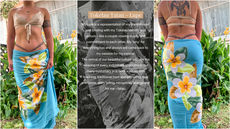
Tokelau Lupe - Zoe So'otaga
Malo ni, ko toku igoa ko Hoe, Zoe So'otaga. Tulou ko au e taumafai ki taku gagana Tokelau. Ko oku matua ko Ana ma Mauailegalu Mathew So’otaga, Ko na matua o toku tamana, Ko Kolotita ma Tuaiao So’otaga. Ko na matua o toku matua ko Phillip Venning ma Nive Ahelemo Venning E toka fa te matou fanauga, e toka lua oku tuagane ko Wyatt ma Vele, ma toku uho tamaiti te matou ki muli ko Mia, ko au te ulumatua, kua lua hefulu tolu oku tauhaga. {{21304}} From a young age, as many of us do (afa-kasi’s in particular) – I experienced extreme identity issues. As a half Samoan, quarter Tokelauan, NZ european fatupaepae I found the expectations from all cultures as well as modern day New Zealand born and raised challenging, but I would never admit it. I found on occasions that I would try to connect through language or traditions, and would be shut down or laughed at for trying. {{21309}} Countless times I’d hear that I was ‘too white’...but I also felt too ‘brown’ for the white world. It felt like an endless worm hole that made me swallow all my emotions towards the subject. I am grateful for my fanau for always being accepting of me, where ever I sat in the ‘Samoan enough’ societal scale. In particular my aunties and uncles, I always felt like I was good enough for them and it was the only place I felt comfortable slipping up trying to be the best pasifika girl I could be. {{21314}} My grandparents always pushing me to be more and more Samoan/Tokelauan, it was hard and confusing at the time but I am grateful. I still don’t speak my mother tongues, but put me in an i’e and tell me to serve the front table – I know how to do it. I carry traditions in my values of respect and service to my people. I hold my identity and story on my skin within my tatau. {{21307}} This Tokelau tatau was inspired by one of the very little sources out there on Tokelau tatau. Figure 23 on Sean Mallons research ‘The history of Tokelau tatau’ show’s an image of a ‘lupe’ around the womans waist. In Gordon Macgregor’s research for ‘Ethnology of Tokelau islands’ pg 144 it notes that “All women were tattooed with a band (lupe) below the waist line, commencing at the iliac crest and extending around the back just above the buttocks or sometimes converging from the sides into a point over the lower part of the sacrum (fig. 23, d). This band was covered by the leaf skirt (titi) and was never tattooed until the woman was married”. {{21311}} Although I am not married I decided in discussion with my mum and Tyla Vaeau that there is a need for the revival of these traditions and waiting for my marriage is far too long to wait (haha). Our culture is dying and language is not the only way we can revive all the traditions. My first step to this is my pasison and talent in the arts and traditions of tatau. My lupe is a representation of my commitment and binding with my Tokelau identity and culture – like a couple vowing loyalty and commitment to each other. {{21321}} My ‘why’ for everything has and always will come back to my passion for my people. The revival of our beautiful culture will take the weaving of every individuals strengths in our many customary practices such as: oral teaching, traditional food and gathering, hiva and fatele, story telling, navigation, lalanga and for me - tatau. Fa’afetai lava Tyla Vaeau , whakawhetai lahi lele mo te avanoa.
-
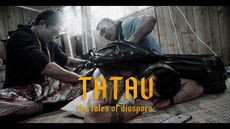
Tatau | Tales of diaspora 2020
A personal journey for Benji Timu, a second-generation Aotearoa-born Samoan receiving the Pe'a, covering the body from the knees to the waist. A recollection of the seven days of this spiritual and painful experience.
-
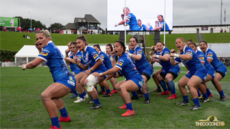
INKED - SUI TAUAUA-PAUARAISA - TALES OF TATAU
Masuisuimatama'ali'i (Sui) Tauaua-Pauaraisa is a professional rugby union and rugby league player. She has represented Samoa in both rugby union and rugby league, and she has also played rugby league for the Kiwi Ferns and the Warriors! Whenever she's on the field, you can see her beautiful malu on display!
-
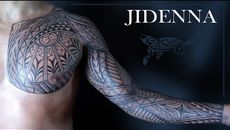
ISLAND TAT - JIDENNA'S POLYNESIAN TATTOO
Warning: Explicit Lyrics American rapper, singer & songwriter Jidenna was recently on The Breakfast Club and talks about his Polynesian sleeve which was done by Chamorro Tattoo artist Joshawa Elsas. Peep the interview below on why he decided to get Poly designs. {{14004}} And get to know Joshawa Elsas from IslandTat here - {{14005}}
-
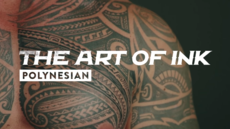
POLYNESIAN TATTOOS - THE ART OF INK SEASON 2
Polynesian tattooing is a way to make sure traditions are never forgotten. For artists like Si’i Liufau, Mike Fatutoa, and Alipate Fetuli, it’s even more. It's a first language. The 'Ink Master' crew sets off to explore the different individual styles of tattooing, what makes them unique and the artistry it takes to execute them.
-
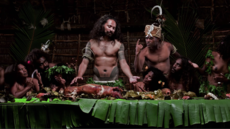
GREG SEMU 'AUTO PORTRAIT WITH 12 DISCIPLES'
Born in New Zealand, curator, artist and self-taught photographer Greg Semu embraces his Samoan culture and ancestry in his mural-sized photograph, The Last Cannibal Supper, Cause Tomorrow We Become Christians, held in the collection of the National Gallery of Australia. This work is from a series of images he created in 2010 while in residency at the Tjibaou Cultural Centre, New Caledonia and directly references the iconic 15th-century fresco by Leonardo da Vinci, The Last Supper in Milan, Italy. Here Semu is not only the creator/photographer but the subject too. He is the central Jesus figure, resplendent in his Samoan waist-to-knee pe’a tattoo, with local Kanaks as the 12 disciples, set before a feast of traditional Samoan food. Semu seduces and challenges the viewer with his finely crafted and carefully staged photographic tableaus. In faux-documentary style, Semu depicts an imaginary moment in history when Samoan people were cajoled by the missionaries to give up their traditional practices, rites and Gods, in order to embrace Christianity. His image conveys that turbulent moment, rich with irony and a touch of humour. In the video, Semu discusses the profound impact Christianity has had on his people and, in particular, local customs such as cannibalism. Strewn across the table are many items of traditional Samoan food including pigs, taro and yams but also prosthetic human limbs and a skull. While Christian missionaries sought to banish such ‘savage’ customs, Semu draws attention to the similarities of rites of the Last Supper where the bread and wine symbolise the body and blood of Christ. Provocatively, one of the disciples is presented as a bare-breasted female. Here references are made to the western tradition of ethnographic photography depicting naked natives in ‘Garden of Eden’ settings, as well as Semu’s own interest in the French artist Paul Gauguin’s Pacific work from the late 19th century and renowned French painter Eugène Delacroix in his major history painting Liberty leading the people created in 1830. In Semu’s last supper, he draws attention to the negative impact of colonial intrusion into indigenous cultures and questions notions of the primitive and savage, while attempting to regain lost heritage by restaging grand European narratives with indigenous people taking centre stage.
-
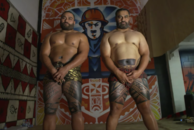
SAMOAN AND TONGAN TATAU
Two brothers, two different tatau - the Tongan and Samoan pe'a. Many Tongans have tried to revive the lost art of Tongan tatau, and what these age old patterns would have been. Rob and Sione Pomee from Three Houses Down undertook an extraordinary journey together to get a Samoan pe'a celebrating their Samoan ancestory and re-imagining the Tongan 'ta vaka' tatau.
-
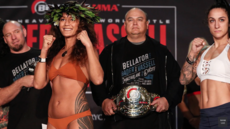
INKED - ILIMALEI MACFARLANE
Bellator Fighter Ilima-Lei Macfarlane's traditional Polynesian tattoos represent her family, her Hawaiian heritage, and contain symbols of strength that protect her in the cage. Since getting tattooed, she remains undefeated. Every tattoo has a story, what’s yours? {{13358}}
-
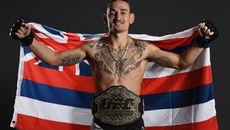
UFC CHAMPION MAX HOLLOWAY BREAKS DOWN HIS INK
Hawaiian-native UFC champ Max Holloway has a full tribal chest tattoo which holds deeper meaning to him than you think.
-
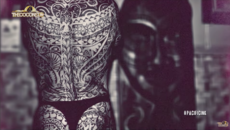
STORMY KARA - Kareha Studio in Rarotonga
Stormy Kara invites us in to check out her tattoo & art studio in Rarotonga, Cook Islands ...
-
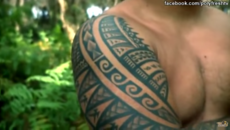
INKED: KING KAPISI & TIANA LIUFAU
Rapper King Kapisi & choreographer Tiana Liufau tell us the stories behind their ink.
-
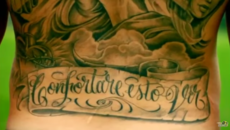
INKED: KURTIS HAIU
In loving memory of Kurtis Haiu who played for the Auckland Blues and died in 2016 after a prolonged battle with cancer. He shared the stories behind his tattoos with us a few years back on FreshTV. #RIP
-
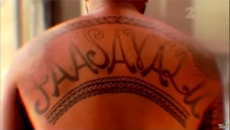
INKED: ERAKAH & TAVAI FA'ASAVALU
Singer Erakah & Actor Tavai Fa'asavalu share their tattoo stories!
-
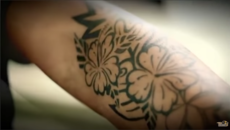
INKED: TANU GAGO
Visual artist Tanu Gago shares his ink he has to represent his siblings - 9 sisters and 2 brothers!
-

The Untold Story Behind Dwayne "The Rock" Johnson's Tattoo
Culture, family and struggle are represented in The Rock's tattoo, as he describes in a "Once in a Lifetime: The Rock vs. John Cena" exclusive video.
-
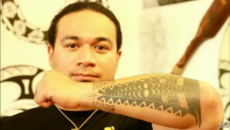
INKED: DAYNA VAWDREY & CARL COCKER
TV/Radio Presenter Dayna Vawdrey & Tattoo Artist Carl Cocker talk about their ink and why it's so special to them.
-
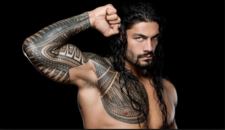
Roman Reigns explains his traditional tattoo
Super Samoan WWE star Roman Reigns reveals why his traditional Samoan tattoo is so important to him! Known for his agression, strength and long flowing locks, check out the story behind his awesome ink and his pride for his culture.
-
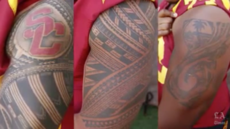
USC Island Ink stories
USC Trojans linemen Zach Banner, Toa Lobendahn and Damien Mama talk about the honor of carrying on their island heritage.
-
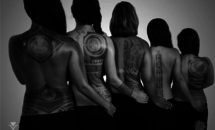
Polynesia Tatau Tattoo Convention 2016
The fifth Polynesia Tatau Festival opened this Thursday at the Museum of Tahiti showcasing local and international tattoo artists. With over 60 tattoo artists across the 4 day event, it's one of the biggest tattoing festival in the South Pacific. Check out some of this year's artists and some of the action from last year's festival! One of this year's featured artists is Patu Manuia of Papaete - check out some of his gorgeous designs!
-
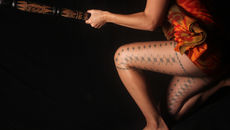
INK SERIES: STACIE AH CHONG-LEVI
MALU You may recognise Stacie's legs from the covers of Lani Wendt-Youngs popular Telesa trilogy. She gives us her back story on where and when she had her malu done and what it means to her as a young woman born & raised in Samoa now living in New Zealand. I got my malu done in Samoa, 2 weeks after my wedding back in January 2010. To be completely honest, growing up, it had not been on my list of ‘things to do’ It hadn’t really crossed my mind – it had always scared me because when you think of a malu or a pe’a you think of the pain that you have to go through. Growing up my grandmother Su’a Frieda Paul & my cousin Ruby were the only ones in our family who had, had a malu done. The idea of getting a malu began to evolve in 2009 when I sat and watched my husband getting his Pe’a done. Watching him go through it, all of a sudden just gave me this real appreciation for the courage you have to have and it’s hard to explain or pinpoint exactly what it was that made me think ‘oh my goodness, I want to get a malu’ I know it’s weird cos you’d think that watching him go through such an ordeal you’d be more like ‘oh hell no I’m never getting it done’ (laughs) but after watching him go through that pain and sitting there for 6 days, 5 hours at a time you really have to have an appreciation for your culture and a very deep desire to want it. Stacies husband Alesana was also the alternate 'Daniel Tahi' novella cover. We had begun planning our wedding to be held in Samoa in January 2010 & there were no plans or even mention of me having my Malu done after. I had been constantly thinking about the possibilities of getting it though and knew that ‘I really, really wanted it now’. It wasn’t until my Aunty To’oa Kristin Taylor who was there for my wedding (she is a very dear friend of my mother’s - they are the founders of ‘T.H.O.R.N’ Ministries) happened to say ‘I’ve been really wanting to get my malu done but what say we all get it done together’ that I began to think ‘Wouldn’t it be so fitting to get it done now’ - we had just sealed our marriage & this could be a new beginning for me. I felt that this was going to add that extra meaning to Alesana and I just being married. They say that the malu means Fa’amalumaluga O Aiga which means peace keeper of the family or to shelter and protect. A women with a malu would be seen as the shelter and protector of her family, her children, and her community. Choosing to get my malu at that time was going to be something of extra significance - a new beginning for me as a wife & a mother for my own little family and a new found love and appreciation of my Samoan culture which I am still learning about everyday. Alongside me was my older sister Natalya, my Mum Papali’i Carol, Aunty To’oa Kristin Taylor, my aunty Therese (my Mums younger sister), my aunty – Leilani Curry and I. There were 6 of us and then my husband’s young cousin Grace also got hers done the same day as I did so she was part of our group as well. It was a very special occasion and to have it done alongside my mother and my older sister gave it more meaning too. Mine took 2 hours. Everyone has a different experience. I know some people who have had it done and they’ve done one leg on one day and then do the other leg the next day. I think it’s really up to the tufuga (Tattooist) because they can feel and judge how the person is taking it and their pain levels but I think it also depends on how busy the Tufuga is as well. We all got done over a week. My malu was done by Su’a Peter Suluape, from memory Su’a Peter did the majority of ours and I think his father Su’a Suluape Petelo did my Mums. Stacie in the middle (looking at the camera) Stacie to the far left Everyone’s patterns are different. It’s an amazing art, when you stand up in front of them, they don’t actually draw anything on you, they’ll mark little dots I guess for the lines but they don’t have any pre-knowledge of what designs they’re going to actually put on you. So it’s totally up to the tufuga. I know that you can request to have certain patterns that you may have a family connection with or if you have a certain interest in, I don’t think there’s any 2 malus that you’ll come across that are exactly the same. You will see many that may be similar because the designs are much the same but each is unique. The diamond pattern behind the knee is the only part that is much the same and that diamond is what is called the “malu” which means protect, all the other designs are decoration. Each design and each pattern all have different names to them and from what I know all of them are pertaining to the earth, land and sea. So you’ll come across ones called ‘Gogo’ (Seagull), ‘Fetu’ (Star) or ‘Alualu’ (Jellyfish). Whether you’re getting a pe’a or malu the tufuga will give you a full list of things you’re not to do during the process especially for the pe’a because they take longer than a day to complete. With the malu its much the same but because it doesn’t take as long, the only thing they did say to us was that until we’d had the ‘Samaga’ I had to sleep on the floor, I wasn’t allowed to sleep on the mattress. So, because there were 7 of us in our group and I got mine done on Tuesday I had to sleep on the floor until the others had finished – they also ask you to make sure you take a shower a number of times throughout the day to massage out the ink so it keeps the infection away, this is a very important part, you must also keep out of the sun. The ‘Samaga’ or blessing is the ceremony done at the end of both the pe’a and the malu. The tufuga will say a prayer and there may be songs sung. There is then the presentation of gifts and payment to the tufuga from you and your family, following on from this the Tufuga will do the cracking of the egg on the head – they call this the rebirth and it’s the blessing you receive upon completion of your Pe’a or Malu, this signifies that you’re now a woman or a man of the earth. The tufuga will stand up and say a silent prayer while he’s cracking the egg on your head, he’ll then get the lega (mixture of coconut oil with turmeric or it might be curry powder or moso’oi I think) and they oil your whole body from head to toe starting off with the malu. It will then finish off by you preforming your siva or celebratory dance. A lot of people say you shouldn’t actually get a malu or a pe’a until you have full knowledge of the Samoan culture and that’s what a lot of the controversy is at the moment. They say that unless you have the full knowledge of it you’re just getting it for the sake of it and that it’s all for show. To be completely honest I didn’t know too much about it before getting it done but for me, like I said before, it was a new beginning and also the start in my journey to learn more about my culture. It’s been such a positive for me and I’ve learned so much about it & im excited to keep learning. Not going to lie – that first tap – oh my goodness, all I kept thinking was, what am I getting myself into? All I wanted to say was ‘stop, that’s enough! I don’t want to go through with it’ (laughs) but the feeling you get when its complete - I can’t explain it! Everyone’s always like oh what’s the pain like but you can’t explain that. I mean it hurts – it really hurts but it’s a pain you can’t explain, I always compare it to childbirth. The pride you feel just comes over you when it’s complete and when I stood up after it was done I stood up to do my celebratory dance and a wave of happiness swept over me and I had never felt so proud not only of myself but of my Samoan culture, I danced the Siva Samoa with so much pride, the tears just kept streaming, I felt like I could now say I am a true tama’ita’i Samoa. (not saying that you need to have a malu to be a true tama’ita’I but it gives me that personal feeling for myself as an individual) , I may still be learning about my culture and how I can be a better tamaitai but I am proud of who I am & my culture. My malu represents that and I am proud to show that everyday. I am also proud of those that have had the courage to get their Malu or Pe’a done and know that everyone has their own reasons why. Photo credit: PeninaJoy Photography
-

INK SERIES: AARADHNA
Aaradhna gives us the background story on her ink "Andy Tauafiafi from Taupou Tatau in Wellington has done my tattoos - both my hands, my right foot and my neck/chest. Andy came up with the design and stuff I just told him the idea which was something Indian kind of like a medley and also Island designs and then he just drew it up" . Painwise my neck was fine it felt like a scratch but when it got down to the bone thats when I felt the pain (laughs) even though it's a little line but it wasn't too bad because the designs not too full on, like it's not a huge design. The breast bone too - that hurt! . I always go to Andy, he did my hands a couple of years back and I just wanted to get something that represents my culture and you know this is just me just showing off my blood you know? This is what runs through my blood and this is what it represents - Samoan/Indian. There's the Indian designs and the Samoan designs kind of runs through it and my foot design is the same again - a mixture of both. .
-
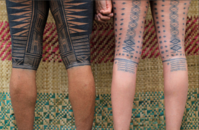
INK SERIES: TESSA APA
MALU Timena Apa writes about her palagi mother Tessa receiving her malu. She writes from her own perspective and what she learned herself through the process. “My mother, a palagi, accepts the gift of the malu. A tatau to match her husband. A magnificent pair. A woman who married Samoa 25 years ago, a country that embraced her with open arms. A land that chose her bones to bear it’s children. Some will argue that a palagi is not fit to wear it, but who are they to question her heart for Samoa, her heart for her husband, her heart for her children? The right to wear a malu is not indicative of blood or skin tone, it is a matter of spirit, and the spirit of Samoa dwells within her, always.” These were the words I posted to my Instagram account last month, accompanied by a photo of my mum getting her tatau. The reason I posted this was an attempt to justify my mother’s actions. Explain to those who didn’t understand or agree, the reasons why she, a non-Samoan, was receiving a traditional Samoan tatau. Admittedly, my intentions were somewhat desperate, not to mention selfish. I needed to ensure that people wouldn’t judge her. I had to defend my mother. In retrospect, this was fatuous. I shouldn’t have needed to justify her malu to anyone, so why did I feel so compelled to? When my Mother first told me she was getting a malu, my immediate response went something like “Why? You’re not even Samoan? That doesn’t make sense”. I was so confused and truthfully, annoyed. How ridiculous. This reaction I assume, is not uncommon, and I’ll admit that I’m embarrassed and ashamed that I felt that way. After much conversation with my family and the tufuga (tatau artist), I became aware that my response was fed by ignorance. I knew nothing about Samoan tatau, other than how beautiful it looked and how proud I was to say it belonged to my culture. In reality, I am your classic Afakasi, who lost the language of Samoa at age five. Despite my slow efforts to climb back into my culture, I still scrape the barrel when understanding Fa’a Samoa. So what leg did I have to stand on when questioning my mother’s decision? What I have learnt is that traditionally, "Malu" derives from both the word "Fa'amalu" which means to protect or shelter, and the word "Mamalu" which means sacred. Historically, when a woman was given a malu, she was seen as a protector of the village, a person who would shelter the family from harm. Over the years, the meaning and significance has warped and evolved, like most things do. The Christian religion has caused many of the older generation to believe that the tatau is not of God. Many Samoans are still fiercely protective of the tatau and would say any non-Samoan is undeserving. There are so many reasons to dispute a palagi receiving a Samoan tatau, but all of these reasons can be rebutted with equally valid arguments in support of it. The Malofie taught me more about pushing my innate perceptions to the side and allowing alternative content to take a seat. You don’t have to let a new idea bolt itself permanently in your mind; just give it a chance to convince you. Like anything, subjectivity is important. In my case, my mum has been married to a Samoan matai (chief) for 25 years. She has three afakasi children and she lived in Samoa for a year when she was ten years old. But should I have to explain this to validate her malu? To some extent, yes. I think it’s pertinent that there is reasoning behind action. Anything that touches on cultural affairs these days requires investigation and explanation. At the same time, I just want to post a picture of my palagi mum and her malu, without explaining why she has it. I want people to use their initiative to unravel and appreciate things for themselves. But is that too much to ask? And, whose job is it to try and offer an alternate perspective? Mine? Yours? All I can say is this; my mother was my first home, my earthly creator, my fierce protector and my unwavering shelter. Everything about the malu and its meaning describes my mother. When I see it on her skin I am reminded of everything she is. The malu gives as much to my mother, as she gives to it. She is married to her malu, and I think Samoa has waited patiently for 44 years to give it to her. I thank the malu, and I thank Samoa for teaching me this. - Timena Apa
-
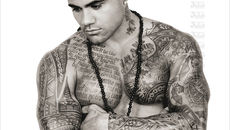
INK SERIES: SAM RATUMAITAVUKI aka FORTAFY
He’s a rapper, a nightclub promoter, business marketer, is a former Mr Suva body building champ and has one of the biggest social media followings on Facebook! Sam Ratumaitavuki aka Fortafy shares with us his stories behind some of his ink. "I got my first tattoo when I was about 14 years old. I got it at home, I remember the guy came around and he hooked it up and my brother and I got the same one. It was a family design taken from some sort of family tapa from where we're from in Fiji. My Dads Fijian and my Mums Welsh but we grew up in New Zealand" "After that one it was a long time before I got any other tattoos, probably waited another 3 or 4 years or so because I was still young. Then my mate hit me up and was like "bro I'll tattoo you for free if you promote me on facebook" and I was like "yeah? oh hell yeah man" so he'd tattoo me and I'd promote him on facebook and it worked out to be a really great relationship. He ended up quitting his factory job and tattooing full time. He's Samoan and based out in Logan, Brisbane. In Australia it's hard to find tattoo artists who can do island designs, they mostly work from home and it's not like you can open a yellow pages and look them up type thing so getting his name out on facebook really worked for him" Eagle tattoo on Sam's neck "Then Valley Ink who are based in Fortitude Valley, Brisbane they hit me up to do like a sponsorship type deal with them and they did my eagle. The meaning behind that is when you look up in the sky the only bird that doesn't care is the eagle - they rule the sky. So you have the sparrows and they're like darting in and out but the eagles just chillin up top like no-one touches the eagle in the sky so thats why I had that one done." "Valley Ink also did my hands which says 'Pain is temporary, Pride is Forever' and the meaning behind it is pretty obvious but that was the first quote I'd heard when I was at boarding school (Wesley College) and it kind of stuck with me and it was a quote I related to. When I first read it I printed it out and stuck it on the wall in my dorm." 'Pain is Temporary, Pride is Forever' - hand tattoos "I got 'Ambition' on my stomach and I don't know, I'd always wanted something on my stomach but I didn't know what and then I've always liked that word and it's kind of taken off to where I use it in every area of my life - music, working out, the business side of things. No matter where you're from you can do anything if you have ambition, if your minds there and you surround yourself with good people you can do anything you want and thats what I really want to portray to other people and youth. So people who can relate to me, if they see me doing good then hopefully they can take inspiration from that." Ambition tattoo on Sams stomach and the Rose symbol on his neck "Then this one here is a Tupac poem - 'The Rose that grew from Concrete' - man when I read this poem it really blew me away, the words are just beautiful. Basically saying that something beautiful grew from a crack in the concrete. Like a rose isn't supposed to grow out of concrete and when you look at him, he wasn't supposed to do what he did but he became the voice of so many and peoples idols. So I got the rose on my neck as like a symbol but then I wanted to get the whole script so I had that done on my chest. The music symbols pretty self explanatory and the stars - Aim High" The "Rose that grew from Concrete" Tupac poem/verse script on Sam's chest "I've got the cliche angel wings on my back (laughs) and it's got like island patterns throughout it. There's not really a story behind it, kind of along the same lines of 'aim high and fly' type thing. I got it done at 'Valley Ink' and they had me at the front of the store which is on a main street and they had me right next to the window so people would be walking past taking photos and I'm in pain trying not to cry but having to smile (laughs) it was so annoying aye?" Sam's back tattoo "I did a track called "Body Marked Up" and that whole verse pretty much sums up all the ink I have on my body up to this point ... "I got roses on my neck, wings on my back I don't mess with colour, my ink will remain black I'm naked without that if you try to detract, the rose that grew from concrete, now they all believe in that see, cos I just ink it on my skin, tattoo, I got my ex on my wrist, my other arms got my crew, it's vital to what I do, the journey I've been through, tattoo'ed like a canvas, what I'm into See I'm im in tune to my island roots, I got my chest and both arms to pay homage to, Tattoos one fact I'ma leave you, the only word in the dictionary for my people, See through it all, the pain on display ...." Since we last met with Sam he has had more tattoos completed including this portrait of his father which was done in memory of him after he passed away in 2012.
-
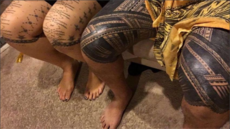
INK SERIES: Fa'afetai & Toefuiono Fa'aleava
MALOFIE & MALU - A brother & sister share their journey ... Fa'afetai (Tai) & his younger sister Toefuiono (Ono) received their Malofie & Malu (Traditional Samoan tattoo's) together last year. They both live in San Francisco, USA and share their experience and why they went through the journey. Tai is 30yrs old and is currently doing his doctorate in Clinical Psychology at Alliant International University in San Francisco. He also works as a psychological trainee, providing mental health services to clients who are on federal probation. Toefuiono (Ono) is 23yrs old and currently works as a Revenue Transition and Registration Specialist for University/Stanford Healthcare. Ono & Tai on a recent trip back to Samoa for Ono's Moananu Saofa'i Tai: - I was born at Moto'otua hospital in Samoa. I grew up in Vaiusu (Dad's family), Malie (Mom's side) and Fagae'e in Savai'i (my parents first ministry post after graduating from Malua Theological College) until I was 5 yrs old. Ono was also born in Samoa but we left to Jamaica when she was a few weeks old. From Samoa, we moved to Jamaica for 5 years and this is where I learned English (Patois) - My Dad looked after some churches there. We then lived in New Zealand for 8 years where I attended Papatoetoe High School. Our family moved to America in 2006 when I was 19yrs old and we lived in San Jose and then moved to San Francisco in 2013. The Fa'aleava family in Auckland, New Zealand. Tai: - Growing up, my late grandfather To’omata Robert Schuster would always encourage me to honor God, learn the Samoan culture and pursue education to its highest level. Every time he would see me walking around without a shirt on he would always say “E manaia lou tino pe a na iai sau pe’a” which translates to “your body would look much nicer if you had a tatau”. Tai and his late Grandfather To'omata Robert Schuster and his cousin Vaipuese Schuster who now has a Malu. Perhaps also influenced by her grandfather. I was 13 years old at the time, and two of my Mom’s brothers had already completed their tataus. This was the birth of my inspiration to get a tatau. At age 27, I was bestowed the “Muliagasisila” title from the village of Lano in Savai'i; my paternal Grandma’s aiga (family). This made me want the tatau even more. Tai receiving Ava for his Muliagasisila title in Lano, Savai'i Many tufugas visited America to conduct tattoo sessions, but it was always during a time when I was in school. However, at age 29, I was fortunate to have met Tufuga Su’a Wilson who was visiting San Francisco, and he was able to give me my tatau. Among my parent’s siblings and their children, there are 5 Soga’imiti(s) and 5 Malu(s). Traditionally the tatau is done in pairs or more. The person/people who you are tattooed with are called “soa”. The significance of having a Soa is a reminder that the tatau does not belong to any one individual but in fact a commitment to a life of service to your people, village(s) and country. My Soa was my little sister Moananu Toefuiono Faaleava. Ono: - Growing up I wasn’t much of a tattoo fan so the Malu didn’t cross my mind as something I really wanted to do. However, when my brother finally confirmed having his Pe’a done, I had a sudden urge to get my Malu done alongside him for support. Tai: - The Tufuga who tattooed my sister and I last year in San Francisco was Su’a Wilson Fitiao from American Samoa. The Tufuga was visiting family in San Francisco and finishing a pe'a that he had started the year prior. I got word that he was in town and asked to be tattooed. Every morning he showed up to my house at 9am sharp (this was very anxiety provoking) had breakfast and would start tattooing around 9:30am. Sessions were approximately 4 hours per day. On my first day I did a double session (back & butt) so that was about 6 hours straight. Ono's sessions were about 3.5hrs per leg. She did each leg on separate days so the Tufuga could have a session with me afterwards. Ono started her Malu on my second day, and completed it on my third day, then I continued on alone for an additional 8 days. Mental and spiritual preparation was the most important for me. I spent the week prior to my first session praying and listening to old Samoan songs. Since I live in America, Samoan music was how I connected with my culture and country. My parents notified their respective sides of the family and with their blessing, support and prayers, my sister and I were able to complete our tatau’s. It was by far the worst pain I have ever experienced in my life. Since I already had tattoos prior to my tatau, I thought I knew the level of pain to anticipate, but that was not the case. The pain of the tatau was at a level beyond excruciating. After the first few taps on my back, the first image that came to my mind was Jesus being whipped before his crucifixion. I could physically feel my brain trying to comprehend what my body was going through. Questions of doubt flooded my being but it was too late, the first mark of the tatau had been inked into my skin; there was no going back. I refused to be a “pe’a mutu” (Individual with an unfinished tatau) so I laid there and endured the pain. After hours of agony, I finally found an escape from my physical reality. I mentally drifted away to a place where I was met by both my late paternal and maternal Grandparents. The four of them did not utter a word; they simply stood around me and watched my tatau process. I was comforted by their existence within this spiritual realm that I somehow stumbled into. I rushed to this spiritual space every day during my tattoo sessions to find peace and perseverance. Ono:- Most definitely the worst pain I’ve ever had to deal with. Unlike my brother the pain was much too excruciating for me to drift off. I dealt better with the pain by squeezing my family members’ hands and singing Samoan songs (which were playing in the background) out loud. After getting my first leg done, I was dreading the day I had to do my second leg. So, of course when it was finally over I was very proud and extremely ecstatic knowing I’d never have to deal with that pain again. Tai & Ono with their completed tatau during the Samaga. Tai: - As soon as I heard the Tufuga say “Welcome to the [tatau] family”, I was overwhelmed with pride and joy. I remained on the floor for a while, and thanked God for his protection over me while I was getting tattooed. I could finally sleep peacefully at night knowing that there would be no subsequent tattoo sessions to follow. It was a very proud moment and huge sense of relief. L-R Solo & Apprentice Lau Moliga, Tai & Tufuga Su'a Wilson Fitiao
-
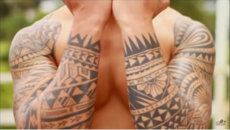
INKED: STEVE TAPA MAHE
Steve tells us the story behind his Ink which is a mix of Tongan, Samoan & Marquesan designs
-
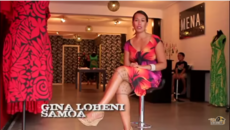
INKED: CZARINA WILSON & GINA LOHENI
Tongan Czarina Wilson & Samoan Gina Loheni share with us the stories behind their tattoos.
-
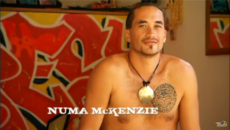
INKED: NUMA MCKENZIE
Canadian born and raised Cook Islander Numa Mckenzie goes back to the islands and gets some fresh ink while he's there. He tells us the story behind both his Mangaian (Cook Island) ink and NZ Maori designs.
-
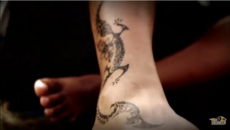
INKED: ANNE HUKIAVAVE
Anne Hukiavave who is of Cook Island & maori descent shares the story behind her ink and the meaning of the different patterns.
-
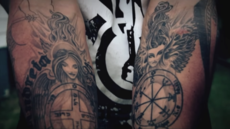
INKED: RON & TOMA AMOSA
Brothers Ron & Chris (Toma) Amosa show us their ink & talk about their tattoos, when they first got them & some of the stories behind the ink .....
-
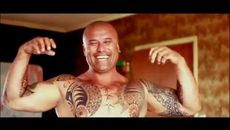
INKED: MARIA TUTAIA & AMON TA'AKIMOEAKA
Silver Fern Maria Tutaia and NRL Agent Amon Ta'akimoeaka tell us the stories behind their ink.
-
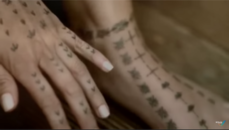
INKED: LULU TEPAERU ARIKI-FRENCH & CARLA McMASTER
Cook Islander Lulu Tepaeru Ariki-French & Samoan Carla McMaster show us their Pacific Ink and what their designs mean to them.
